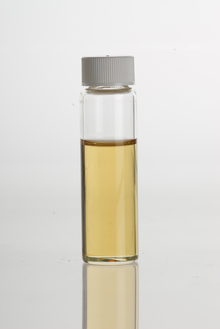Sage oil

Sage oils are essential oils that come in several varieties:
Dalmatian sage oil
Also called English, Garden, and True sage oil. Made by steam distillation of Salvia officinalis partially dried leaves. Yields range from 0.5 to 1.0%. A colorless to yellow liquid with a warm camphoraceous, thujone-like odor and sharp and bitter taste. The main components of the oil are thujone (50%), camphor, pinene, and cineol.[1]
Clary sage oil
Sometimes called muscatel. Made by steam or water distillation of Salvia sclarea flowering tops and foliage. Yields range from 0.7 to 1.5%. A pale yellow to yellow liquid with a herbaceous odor and a winelike bouquet. Produced in large quantities in France, Russia and Morocco. The oil contains linalyl acetate, linalool and other terpene alcohols (sclareol), as well as their acetates.[2]
Spanish sage oil
Made by steam distillation of the leaves and twigs of S. officinalis subsp. lavandulifolia (syn. S. lavandulifolia). A colorless to pale yellow liquid with the characteristic camphoraceous odor. Unlike Dalmatian sage oil, Spanish sage oil contains no or only traces of thujone; camphor and eucalyptol are the major components.
Greek sage oil
Made by steam distillation of Salvia triloba leaves. Grows in Greece and Turkey. Yields range from 0.25% to 4%. The oil contains camphor, thujone, and pinene, the dominant component being eucalyptol.[3]
Judaean sage oil
Made by steam distillation of Salvia judaica leaves. The oil contains mainly cubebene and ledol.[4]
References
- ^ Karl-Georg Fahlbusch; et al. (2007), "Flavors and Fragrances", Ullmann's Encyclopedia of Industrial Chemistry (7th ed.), Wiley, p. 113, doi:10.1002/14356007.a11_141
- ^ George A. Burdock (2010), "CLARY OIL", Fenaroli's Handbook of Flavor Ingredients (6th ed.), Taylor & Francis, pp. 327–328, ISBN 978-1-4200-9077-2
- ^ Ivana Cvetkovikj; et al. (2015), "Essential oil composition of Salvia fruticosa Mill. populations from Balkan Peninsula" (PDF), Macedonian Pharmaceutical Bulletin, 61 (1)
- ^ Andrea Böszörményi; et al. (2009), "Chemical and Genetic Relationships among Sage (Salvia officinalis L.) Cultivars and Judean Sage (Salvia judaica Boiss.)", Journal of Agricultural and Food Chemistry, 57 (11), doi:10.1021/jf9005092
